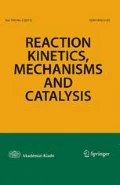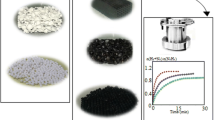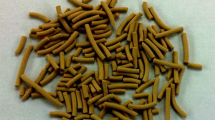Abstract
The influence of the catalyst support shapes on the performance of liquid monopropellant thrusters was investigated. In the present work, two supports: monolith honeycombs and alumina grains were tested and their relative performances were compared. Ir-monolith catalysts with total metallic contents of 30 wt% in mass were prepared by the wet impregnation method. The characterization of these materials, before and after their use for liquid monopropellant decomposition in a satellite thruster, was performed by measurement techniques of specific surface area, H2 chemisorption, ICP, SEM and TEM measurements. The catalytic decomposition tests display the best catalytic activity for the grain catalyst (Shell 405) with a complete decomposition of liquid monopropellant, due to a good contact between solid–liquid phases, and monolith catalyst with longer catalyst bed. Moreover, the monolith catalyst leads only to partial liquid monopropellant decomposition, due to injection model and preferential channels through the catalyst bed. The performance of the thruster when using monolith honeycomb and alumina grains as the catalyst bed was evaluated by measuring the product-gas temperatures and pressures at different points of the catalyst bed.










Similar content being viewed by others
References
Cybulski A, Moulijn JA (1998) Structured catalysts and reactors. Marcel Dekker, New York, USA
Moulijn JA, Leeuwen V, Santen V (1993) An integrated approach to homogeneous, heterogeneous and industrial catalysis. Stud Surf Sci Catal 79:5–8
Klein N (1988) Gun propulsion technology. In: Stiefel L, Summerfield M (eds) Progress in astronautics and aeronautics. American Institute of Aeronautics and Astronautics, Washington DC
Comer RH (1976) Proceedings of the 16th international symposium on combustion. The Combustion Institute, Pittsburgh
Vosen SR (1988) 22nd international symposium on combustion. The Combustion Institute, Pittsburgh
Vosen SR (1989) Concentration and pressure effects on the decomposition rate of aqueous hydroxylammonium nitrate solutions. Combust Sci Technol 68:85–99
Vosen SR (1990) Hydroxylammonium nitrate-based liquid propellant combustion. Combust Flame 82:376–388
Oberle WF, Wren GP (1990) Closed chamber combustion rates of liquid propellant 1846 conditioned ambient, hot and cold vulnerability testing of liquid propellant LGP 1846. In: Proceedings of 27th JANNAF combustion subcommittee meeting, vol 557. CPIA Publication, Huntsville, pp 377–385
Oberle WF, Wren GP (1991) Burn rates of LGP 1846 conditioned ambient, hot, and cold, ballistic research laboratory technical report no. BRL-TR-3287
Jennings ST, Chang Y, Koch D, Kuo KK (1997) Peculiar combustion characteristics of XM46 liquid propellant. In: Proceedings of 34th JANNAF combustion subcommittee meeting, vol 662, pp 321–331
Zhu DL, Law CK (1987) Aerothermochemical studies of energetic liquid materials: 1. Combustion of HAN-based liquid gun propellants under atmospheric pressure. Combust Flame 70:333–342
Call C, Zhu DL, Law CK, Deevi SC (1997) Combustion and microexplosion of HAN-based liquid gun propellants at elevated pressures. J Propuls Power 13:448–450
Kounalakis ME, Faeth GM (1988) Combustion of HAN-based liquid monopropellants near the thermodynamic critical point. Combust Flame 74:179–192
Lee TW, Tseng LK, Faeth GM (1990) Predicted (DSF method) phase velocity variation along axis of combusting LGP1845 sprays at 10 MPa. J Propuls Power 6:382–391
Van Dijk CA, Priest RG (1984) Thermal decomposition of hydroxylammonium nitrate at kilobar pressures. Combust Flame 57:15–24
Cronin JT, Brill TB (1986) Thermal decomposition of energetic materials. 8. Evidence of an oscillating process during the high-rate thermolysis of hydroxylammonium nitrate, and comments on the ionic interactions. J Phys Chem 90:178–181
Cronin JT, Brill TB (1988) Thermal decomposition of energetic materials. 29. The fast thermal decomposition characteristics of a multicomponent: liquid gun propellant 1845. Combust Flame 74:81–89
Lee HS, Thynell ST (1997) Proceedings of the 33rd AIAA/ASME/SAE/ASEE joint propulsion conference, Seattle
Lee YJ, Litzinger TA (1999) Combustion chemistry of HAN, TEAN, and XM46. Combust Sci Technol 141:19–27
Bothner-By A, Friedman L (1952) The reaction of nitrous acid with hydroxylamine. J Phys Chem 20:459–462
Hughes MN, Stedman G (1963) Kinetics and mechanism of the reaction between nitrous acid and hydroxylamine. Part I. J Chem Soc B:2824–2830
Morgan TDB, Stedman G, Hughes MN (1968) Kinetics and mechanism of the reaction between nitrous acid and hydroxylamine. Part II. The alkyl hydroxylamines. J Chem Soc B:344–349
Bennett MR, Brown GM, Maya L, Posey FA (1982) Oxidation of hydroxylamine by nitrous and nitric acids. Inorg Chem 21:2461–2468
Bourke GCM, Stedman G (1992) Mechanism of the acid catalysed pathway for the nitrosation of hydroxylamine. J Chem Soc Perkin Trans 2:161–162
Pembridge JR, Stedman G (1979) Kinetics, mechanism, and stoichiometry of the oxidation of hydroxylamine by nitric acid. J Chem Soc Dalton Trans 11:1657–1663
Gowland RJ, Stedman G (1981) Kinetic and product studies on the decomposition of hydroxylamine in nitric acid. J Inorg Nucl Chem 43:2859–2862
Gowland RJ, Stedman G (1983) A novel moving boundary reaction involving hydroxylamine and nitric acid. J Chem Soc Chem Commun:1038–1039
Jones E, Pota G, Stedman G (1994) Autocatalytic waves in the nitric acid–hydroxylamine system: analytical description of the wave velocity. Catal Lett 24:211–214
Bonner FT, Dzelzkalns LS, Bonucci JA (1978) Properties of nitroxyl as intermediate in the nitric oxide–hydroxylamine reaction and in trioxodinitrate decomposition. Inorg Chem 17:2487–2494
Bonner FT, Wang N (1986) Reduction of nitric oxide by hydroxylamine. 1. Kinetics and mechanism. Inorg Chem 25:1858–1962
Oxley JC, Brower KR (1988) Thermal decomposition of hydroxylamine nitrate. SPIE 872:63–69
Klein N (1990) Ignition and combustion of the HAN-based liquid propellants. In: Proceedings of the 27th JANNAF combustion subcommittee meeting, vol 1. CPIA Publication, Sunnyvale, pp 443–450
Amrousse R, Hori K, Fetimi W, Farhat K (2012) HAN and ADN as liquid ionic monopropellants: thermal and catalytic decomposition processes. Appl Catal B 127:121–128
Amrousse R, Katsumi T, Niboshi Y, Azuma N, Bachar A, Hori K (2013) Performance and deactivation of Ir-based catalyst during hydroxylammonium nitrate catalytic decomposition. Appl Catal A 452:64–68
Amrousse R, Hori K, Fetimi W (2012) Iridium dispersion control in Ir/Al2O3-SiO2 catalysts by calcination temperature using chloroiridic acid as catalyst precursor. Catal Commun 27:174–178
Chen X, Zhang T, Xia L, Li T, Zheng M, Wu Z, Wang X, Wei Z, Xin Q, Li C (2002) Catalytic decomposition of hydrazine over supported molybdenum nitride catalysts in a monopropellant thruster. Catal Lett 79:21–25
Chen X, Zhang T, Ying P, Zheng M, Wu W, Xia L, Li T, Wang X, Li C (2002) A novel catalyst for hydrazine decomposition: molybdenum carbide supported on γ-Al2O3. Chem Commun 3:288–289
Goto D, Kagawa H, Hattori A, Kajiwara K (2004) Monopropellant thruster firing test using KC12GA catalyst. In: Proceedings of the 3rd European workshop on hydrazine, Sardinia, Italy
Tian H, Zhang T, Sun X, Liang D, Lin L (2001) Performance and deactivation of Ir/γ-Al2O3 catalyst in the hydrogen peroxide monopropellant thruster. Appl Catal A 210:55–62
Amrousse R, Brahmi R, Batonneau Y, Kappenstein C, Théron M, Bravais P (2010) Preparation of monolithic catalysts for space propulsion applications. Stud Surf Sci Catal 175:755–758
Brunauer S, Emmett PH, Teller E (1938) Adsorption of gases in multimolecular layers. J Am Chem Soc 60:309–319
Amrousse R, Keav S, Batonneau Y, Kappenstein C, Théron M, Bravais P (2011) Catalytic ignition of cold hydrogen/oxygen mixtures for space propulsion applications. J Energ Mater Chem Propuls 10:301–314
Boudart M, Djéga-Mariadassou G (1984) Kinetics of heterogeneous catalytic reactions. Princeton University Press, Princeton
Balcon S, Mary S, Kappenstein C, Gengembre E (2000) Monopropellant decomposition catalysts. II. Sintering studies on Ir/Al2O3 catalysts, influence of chloride anions. Appl Catal A 196:179–190
Pembridge JR, Stedman G (1979) Kinetics, mechanism, and stoichiometry of the oxidation of hydroxylamine by nitric acid. J Chem Soc 11:1657–1663
Rosser WA, Inami SH, Wise H (1963) The kinetics of decomposition of liquid ammonium nitrate. J Chem Phys 67:1753–1757
Acknowledgments
All authors would like to thank Japan Aerospace Exploration Agency (JAXA) for financial support of this work. Dr. Rachid Amrousse expresses gratitude to Dr. Toshiyuki Katsumi for thruster testing and Prof. Keiichi Hori for discussion of obtained results.
Author information
Authors and Affiliations
Corresponding author
Electronic supplementary material
Below is the link to the electronic supplementary material.
Rights and permissions
About this article
Cite this article
Amrousse, R., Katsumi, T., Bachar, A. et al. Chemical engineering study for hydroxylammonium nitrate monopropellant decomposition over monolith and grain metal-based catalysts. Reac Kinet Mech Cat 111, 71–88 (2014). https://doi.org/10.1007/s11144-013-0626-6
Received:
Accepted:
Published:
Issue Date:
DOI: https://doi.org/10.1007/s11144-013-0626-6




